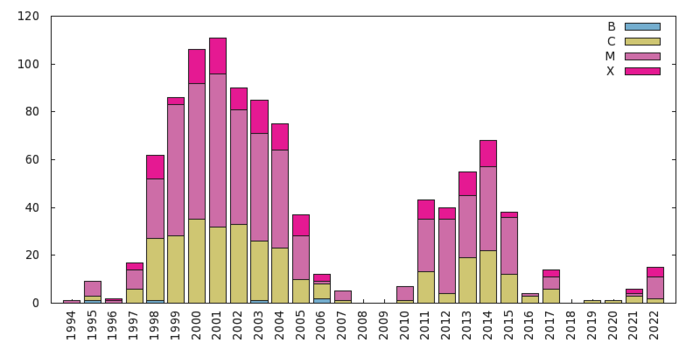KW-Sun: The Konus-Wind Solar Flare Database in Hard X-Ray and Soft Gamma-Ray Ranges
From RHESSI Wiki
| Nugget | |
|---|---|
| Number: | 437 |
| 1st Author: | Alexandra LYSENKO |
| 2nd Author: | |
| Published: | 26 September 2022 |
| Next Nugget: | TBD |
| Previous Nugget: | First Detection of Kink Oscillations with Solar Orbiter |
| List all | |
Contents |
Introduction
Hard X-ray (HXR) and gamma-ray emissions play a primary role in the diagnostics of electron and ion acceleration in solar flares. They provide information about the spectrum, energetics, and abundances of accelerated particles along with acceleration timescales. Therefore hard X-ray/gamma-ray data with high temporal and energy resolutions are of particular interest.
We present a database (Ref. [1]) of solar flares registered by the Konus-Wind instrument during more than 27 years of operation, from 1994 November to the present. The constantly updated database (hereafter KW-Sun) contains over 1000 events detected in the instrument's triggered mode, and is accessible online.
The main objectives of Konus-Wind are the studies of high-energy
transient emission from distant astrophysical sources, such as
cosmological gamma-ray bursts and soft gamma-repeater
(magnetar) flares.
Although the systematic use of the Konus-Wind data for solar physics
applications began only recently, it has already yielded important
results (Ref. [2]).
The KW-Sun database has developed significantly since our 2016
RHESSI Nugget,
with improvements in data analysis and presentation.
Konus-Wind has a number of advantages for solar flare studies compared to other instruments. These include: a high temporal resolution (down to 2 ms) and a wide energy range (20 keV to 15 MeV) in the triggered mode, and the instrument location in interplanetary space, which allows for observations of the Sun in stable background conditions for more than 90% of the time in the waiting mode.
The KW-Sun database
By now Konus-Wind has registered 13,000 solar flares in the waiting mode and 1072 flares in the triggered mode. Annual statistics of the triggered solar flares, categorized according to their GOES classes, are presented in Figure 1.

In the "waiting mode" the light curves are available in three wide energy channels: G1 (now ~20-80 keV), G2 (now ~80-300 keV), and G3 (now ~300-1200 keV), with accumulation time 2.944 s. In the "triggered" mode Konus-WIND measures light curves in the same three channels with time resolutions varying from 2 to 256 ms and with a total duration of ~240 s. Figure 2 shows an example of the light curves from the very recent event SOL2022-01-20T05:55.. Simultaneously, the instrument accumulates 64 multichannel energy spectra in two partially overlapping ranges: at present ~20-1200 keV and ~400 keV-15 MeV. Switching to the triggered mode occurs at a statistically significant excess above background count rate in the G2 energy channel. When accumulation of the triggered mode light curves and energy spectra has been completed, both triggered and waiting mode measurements are interrupted by a gap of ~1 hour because time required the data readout.
For each flare, the database provides time-resolved energy spectra and response matrices in FITS format along with count-rate light curves in three energy bands, G1, G2, and G3, with high time resolution (down to 16 ms) in ASCII and IDL SAV formats. An example of a web interface to the data for a specific flare is given in Figure 2.

Conclusions
The data set of solar observations by Konus-Wind instrument can be used for both statistical and case studies of solar flares. Now with the beginning of a new solar cycle, this may be especially in demand as there is no solar-dedicated instrument in the hard X-ray range near the Earth. The KW-Sun database is a work in progress and data on new flares are added as they become available. The major "to-do task" now is to extend KW-Sun access to the numerous solar flares registered in waiting mode. Future enhancements of KW-Sun will be available via the database website at the Laboratory for Experimental Astrophysics.
References
[1] "KW-Sun: The Konus-Wind Solar Flare Database in Hard X-Ray and Soft Gamma-Ray Ranges"
[2] "X-ray and gamma-ray emission from solar flares"
| RHESSI Nugget Date | 26 September 2022 + |
| RHESSI Nugget First Author | Alexandra LYSENKO + |
| RHESSI Nugget Index | 437 + |